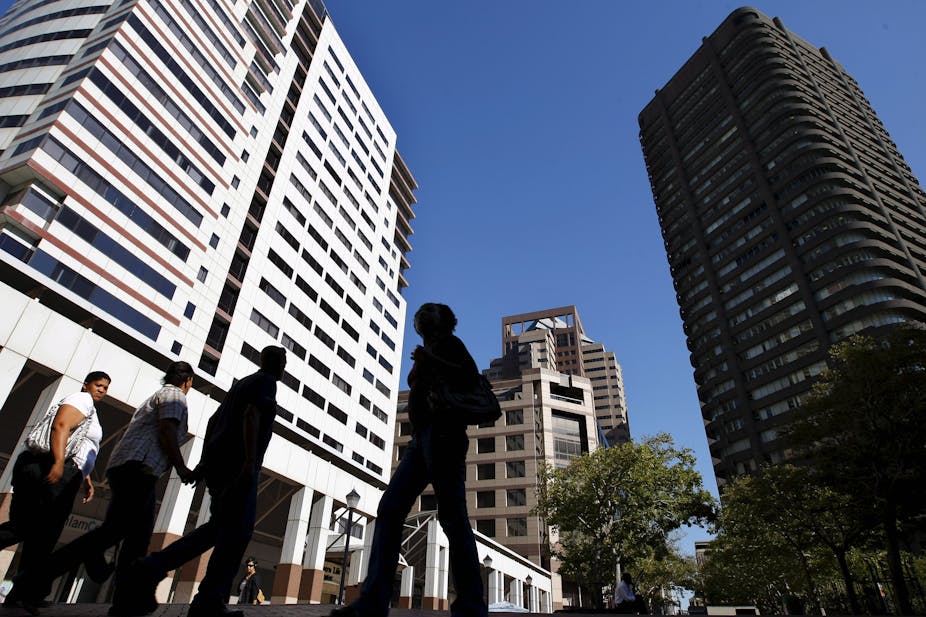It’s an unnerving time for Africa’s banking industry. On August 19, the ratings agency Moody’s announced it had downgraded by a notch the risk rating of South Africa’s four biggest banks – FirstRand, Standard Bank, Nedbank and Absa Bank (owned by UK’s Barclays Bank). Another smaller bank operating in the unsecured loan market, Capitec, had been downgraded two notches a few days earlier.
Normally, the downgrading of a country’s major banks prompts direct concerns about the sovereign rating of the country. But we argue that this is not the case for South Africa, although it does raise indirect concerns about whether the economic drivers of the banking crisis may put the country’s own sovereign rating at risk in the future.
The road to the ratings downgrade all started with African Bank, which operates in the unsecured loan market – handing out loans not backed by an asset. On August 6, the holding company African Bank Investments Ltd (Abil), issued a quarterly operational update via the Johannesburg Stock Exchange’s (JSE) news feed. The general anticipation was that it would be a fairly routine quarterly trading update. Far from it.
The group anticipated an annual headline loss of R6.4bn (£600m) and announced that it would seek to raise a minimum of R8.5bn from its shareholders and other stakeholders. Its long-serving chief executive Leon Kirkinis had also resigned with immediate effect.
The news caught the investment market off-guard. Before the day was out, Abil shares lost R7bn in market capitalisation, followed by a further decline of some 80% the next day.
State-backed bail-in
Late on August 10, Gill Marcus, the governor of the South African Reserve Bank (SARB), the central bank, announced far reaching measures: African Bank would be placed under curatorship and its loan book would be separated into good and bad loans.
The central bank would purchase the bad book (face value R17bn) for R7bn. A consortium of banks and the Public Investment Corporation, South Africa’s largest fund manager investing government assets, also agreed to inject a total of R10bn to recapitalise Abil, via a new entity to be listed on the JSE. The good loans would be moved to the new entity. This is the so-called “bail-in” instead of the usual “bail-out”.
The effective cash injection of R17bn was far in excess of the R8.5bn Abil announced it would seek from stakeholders. The existing funders, however, would take a “haircut” of 10%. And all of this was finalised within two working days of the initial announcement. By any measure this can be regarded as exceptionally swift action by a central bank.
Better than a decade ago
The response to the problems of African Bank – and the downgradings that followed – need to be contrasted to the way a similar South African banking crisis a decade ago was handled. This was about the time that mainstream South African banks became interested in the unsecured loan market. One player, Saambou Bank, began to specialise in that end of the market but ran into difficulties.
On that occasion in 2002, Saambou was placed under curatorship and left to fail. At the time, African Bank acquired Saambou’s unsecured loan book, helping to add a real sense of déjà vu to the current crisis. Saambou’s collapse caused contagion in the domestic banking sector, with a systemic crisis only averted when one of the affected banks, Board of Executors was taken over by Nedbank.
Reduced risk, not heightened
Speaking at a breakfast briefing after the African Bank intervention in August, Daniel Mminele, deputy governor of the central bank announced said that it had acted in terms of the G20 principles.
The central bank made it clear that it was not impressed by Moody’s downgrading of South Africa’s top four banks, nor was the market. The share prices of South African banks declined on the news of the downgrading, but subsequently recovered somewhat.
The complex reasons given by Moody’s for the downgrading are perplexing, but not convincing. It argued, presumably because of the “haircut” for existing African Bank funders, that in future the central bank would not: “fully protect creditors in the event of need”.
But central banks do not directly protect bank’s creditors. The closest to this would be through deposit insurance such as that found in the US. Deposit insurance does not exist in South Africa.
The swift action of the central bank in this case – compared with a decade ago – should actually reflect a reduced risk, not a heightened one. Not surprisingly, Standard & Poor’s, another well-known international rating agency, announced it would not follow Moody’s with a downgrade of banks.
As a result, we argue there is no direct justification of the downgrading of the four banks following the African Bank saga. Yet the cause of African Bank’s problems are firmly rooted in the state of the South African economy. A downgrading which reflects this broader problem is a different matter. And it may indicate that further sovereign down gradings are to follow.
Downgrading the big banks deflected attention away from the question of South Africa’s sovereign risk. The source of African Bank’s problems lie in the inability of unsecured lenders to repay their loans – largely because of the deteriorating economic situation within the country. It is this situation which reflects the greater risk, not Moody’s downgrade, which should perhaps be seen as more of a pre-emptive strike.

